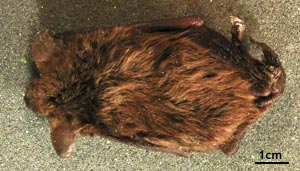Eptesicus fuscus, the Big brown bat, is one of the most common bats in North America. The species range extends from Canada to Brazil. It is an aerial insectivore that uses echolocation (sonar) to detect, locate, and identify insect prey before catching them in the air. Their favorite prey are small beetles, but they eat a wide variety of flying insects.

About the Species
This specimen, a female, was born in captivity and died at approximately six months of age (it has a bird band around its left wrist). It was made available to the University of Texas High-Resolution X-ray CT Facility for scanning courtesy of Dr. Winston Lancaster of Pikeville College and Dr. Timothy Rowe of The University of Texas at Austin. Funding for scanning and image processing was provided by a National Science Foundation Digital Libraries Initiative grant to Dr. Rowe.

A photo of the frozen specimen before scanning.

About this Specimen
The specimen was scanned by Matthew Colbert on 23 January 2002 perpendicular to its long axis for a total of 721 slices (of which the anterior 208 slices are shown here), each slice 0.11 mm thick with an interslice spacing of 0.11 mm. The dataset displayed was reduced for optimal Web delivery from the original, much higher resolution CT data.

About the
Scan
Literature
& Links
None available.

Additional
Imagery
|

